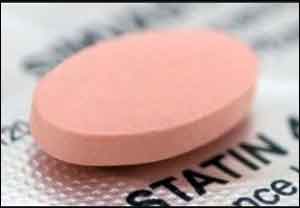- Home
- Editorial
- News
- Practice Guidelines
- Anesthesiology Guidelines
- Cancer Guidelines
- Cardiac Sciences Guidelines
- Critical Care Guidelines
- Dentistry Guidelines
- Dermatology Guidelines
- Diabetes and Endo Guidelines
- Diagnostics Guidelines
- ENT Guidelines
- Featured Practice Guidelines
- Gastroenterology Guidelines
- Geriatrics Guidelines
- Medicine Guidelines
- Nephrology Guidelines
- Neurosciences Guidelines
- Obs and Gynae Guidelines
- Ophthalmology Guidelines
- Orthopaedics Guidelines
- Paediatrics Guidelines
- Psychiatry Guidelines
- Pulmonology Guidelines
- Radiology Guidelines
- Surgery Guidelines
- Urology Guidelines
Statin treatment cuts early seizure risk in stroke patients

Delhi: Statin treatment may lower the risk of acute symptomatic seizure (early seizure: ES) in acute ischemic stroke (AIS) patients, finds a large observational study.
This intervention is important as the early seizure is considered to a risk factor for post-stroke epilepsy and ES early symptomatic seizure (ESS) occurs in 2%-7% of patients following an acute ischemic stroke.
The study, presented at the International Epilepsy Congress, thus concluded that statin may have a prophylactic effect of seizure after stroke.
An early seizure may sometime occur in acute ischemic stroke (AIS) and may increase the risk of post-stroke epilepsy. Previous studies have shown an association between the early use of statins and reduction in the risk of ES in AIS patients but were not found to totally remove effects of confounding factors due to its retrospective study design.
Soichiro Matsubara, Kumamoto University Hospital, Department of Neurology, Kumamoto, Japan, and colleagues aimed to verify determinants and the prognostic significance of ES and clarify the statin effect for ES.
For the purpose, the researchers enrolled consecutive AIS patients having no history of epilepsy admitted to a comprehensive stroke center. ES was defined as acute symptomatic seizure occurring within 7 days after the index-stroke. The relationships between ES and various factors including statin treatment were assessed by using multivariate and propensity score (PS) methods.
Also Read: Statins cut risk of stroke in cancer patients after radiotherapy
Using propensity-score matching to control for potential confounders, the researchers found that:
- Of 2,969 AIS patients (1,144 males, mean age: 74±12 years old), 1,623 (54.6%) were treated with statin in the acute management, 66 (2.2%) developed ES during the hospitalization.
- Use of a statin during acute stroke management was associated with a “robust” 77% reduction in the risk of developing a symptomatic seizure within 7 days after hospital admission.
- 19% of the ESS cohort were on a statin during their acute stroke management, as were 55% of the no-ESS group. Four-fifths of patients on a statin initiated the drug only upon hospital admission.
- Strokes tended to be more severe in the ESS group, with a median initial National Institutes of Health Stroke Scale score of 12.5, compared with 4 in the seizure-free patients.
- A cortical stroke lesion was evident upon imaging in 89% of the ESS group and 55% of no-ESS patients.
- Among ESS patients, 46% had a cardiometabolic stroke, compared with 34% of the no-ESS cohort.
- Mean C-reactive protein levels and white blood cell counts were significantly higher in the ESS cohort as well.
- Their median hospital length of stay was 25.5 days, versus 18 days in the no-ESS group.
- Of the 76 ESSs that occurred in 66 patients, 37% were focal awareness seizures, 35% were focal to bilateral tonic-clonic seizures, and 28% were focal impaired awareness seizures.
- In a multivariate analysis adjusted for age, sex, body mass index, stroke subtype, and other potential confounders, statin therapy during acute management of stroke were independently associated with a 56% reduction in the relative risk of ESS.
- A cortical stroke lesion was associated with a 2.83-fold increased risk.
Also Read: MI and stroke patients on statins have better outcomes
"Acute ischemic stroke causes toxic neuronal excitation because of blood-brain barrier disruption, ion channel dysfunction, altered gene expression, and increased release of neurotransmitters. In animal models, statins provide a neuroprotective effect by reducing glutamate levels, activating endothelial nitric oxide synthase, and inhibiting the production of interleukin-6, tumor necrosis factor-alpha, and other inflammatory cytokines -- this explains the possible mechanism by which statins provide protection against ESS, noted Dr. Matsubara.
To read the abstract click here

Disclaimer: This site is primarily intended for healthcare professionals. Any content/information on this website does not replace the advice of medical and/or health professionals and should not be construed as medical/diagnostic advice/endorsement or prescription. Use of this site is subject to our terms of use, privacy policy, advertisement policy. © 2020 Minerva Medical Treatment Pvt Ltd